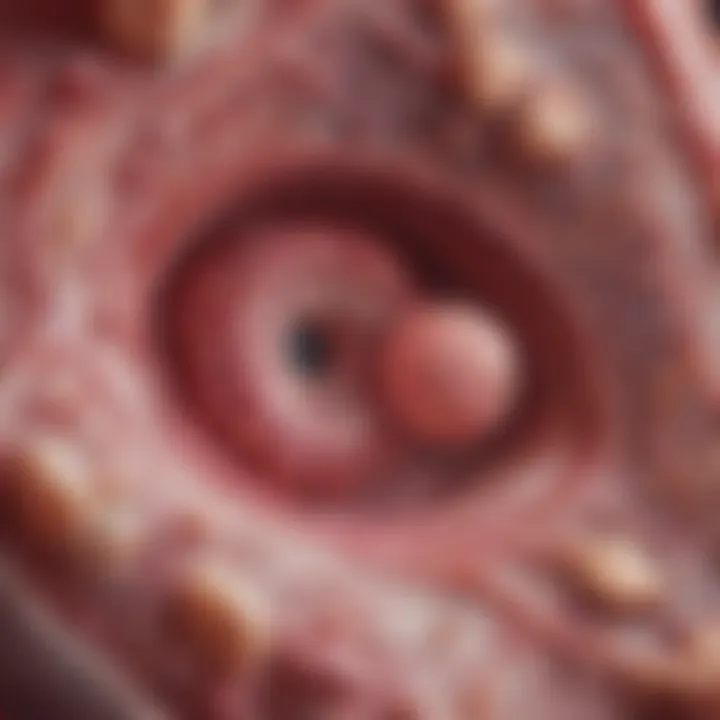Epithelial Tissue: Structure, Function, and Clinical Relevance


Intro
Epithelial tissue is a fundamental component of the human body. It serves multiple functions, including protection, absorption, and sensation. Understanding this tissue is crucial for students, researchers, educators, and professionals in medical fields, as it plays a significant role in health and disease.
In this article, we will explore the structure and types of epithelial tissue, along with its clinical relevance. The intricate nature of epithelial tissue is particularly relevant in regenerative medicine and the study of various pathologies, especially cancer. This comprehensive guide aims to enhance understanding and appreciation for this vital tissue type.
Prelims to Epithelial Tissue
Understanding epithelial tissue is fundamental to comprehending various biological and medical phenomena. This type of tissue serves as the body's primary interface with the external environment, playing essential roles in protection, absorption, secretion, and sensory perception. In this article, we aim to provide a comprehensive overview of epithelial tissue, encompassing its structure, classification, and functional significance, while also delving into its relevance in clinical contexts.
Merging basic biological principles with clinical implications, this discussion seeks to highlight how epithelial tissues are involved in health and disease. This includes understanding their changes in pathological states and their capacities for regeneration. Through this exploration, the importance of epithelial tissue in medical science is underscored, particularly in fields like regenerative medicine and cancer research.
Definition and Overview
Epithelial tissue consists of tightly packed cells that cover body surfaces, line cavities, and form glands. It acts as a barrier that controls permeability and protects underlying structures from injury, pathogens, and dehydration. Additionally, epithelial cells are specialized for different functions depending on their location and structure—varying from secretion in glands to absorption in the intestines.
This tissue type can be broadly classified based on layering and cell shape, which allows for a variety of functionalities tailored to meet the needs of specific organs and systems. Simple epithelia facilitate processes such as filtration and diffusion, while stratified epithelia provide added protection in areas subject to abrasion.
In summary, epithelial tissue represents a complex and essential component of biological systems, influencing a multitude of physiological processes. Its significance expands even further when analyzing its implications in disease and healing.
Historical Perspective
The understanding of epithelial tissue has evolved considerably over centuries. Historically, the recognition of epithelial linings and their functions can be traced back to early anatomists. They categorized these tissues based on observational studies using basic microscopy techniques. As microscopy advanced in the 19th century, researchers began to elucidate finer details about epithelial structures, functions, and their roles in health.
Significant contributions were made by figures like Rudolf Virchow, who introduced concepts of cellular pathology. His work implicated epithelial cells in various diseases, laying groundwork for modern histopathology. This knowledge was crucial in developing the understanding of how epithelial integrity is vital for overall health and how its dysfunction can lead to disease.
With the advent of modern molecular and cellular biology, our comprehension of epithelial tissue has become more sophisticated. Recent research focuses on epithelial stem cells and their potential in regenerative medicine, further enhancing the relevance of this tissue type in contemporary science.
Classification of Epithelial Tissue
The classification of epithelial tissue is a fundamental aspect of understanding its roles and functions in the body. Classifying epithelial tissues allows us to better comprehend their structural diversity and functional capabilities. This classification is broadly based on layering and shape, which are vital parameters in defining the characteristics and purposes of each type of epithelium. Each category reflects unique physical traits and specialized functions that are critical in various organ systems.
By Layering
Simple Epithelium
Simple epithelium consists of a single cell layer. This structural characteristic allows for efficient diffusion, absorption, and filtration. The simplicity of the arrangement is beneficial as it reduces the distance for substances to traverse. Consequently, it is often found in areas where exchange processes occur, such as in the lung alveoli and the lining of blood vessels. One unique feature of simple epithelium is its ability to facilitate quick exchange of materials, which is essential in processes like gas exchange and nutrient absorption. However, the thinness of this tissue means that it provides less protection against physical or chemical insults compared to other types.
Stratified Epithelium
Stratified epithelium is composed of multiple layers of cells, contributing to its primary function of protection. This type is particularly necessary in areas subject to high wear and tear, such as the skin and the lining of the mouth. The key characteristic of stratified epithelium is its thickness, which acts as a barrier against environmental hazards. The presence of several layers protects underlying tissues from damage. On the disadvantageous side, the regeneration of stratified epithelium can be slower due to its complexity, which may affect recovery in injured areas.
Pseudostratified Epithelium
Pseudostratified epithelium appears to be multilayered due to the varying cell heights, but it actually consists of a single layer. This characteristic often leads to confusion. It is commonly found in the respiratory tract, where it plays roles in secretion and movement of mucus through cilia. The unique feature of pseudostratified epithelium is that not all cells reach the surface, allowing for specialized functions, such as filtering air. The downside may be its dependence on ciliary action for effective functionality, making it vulnerable to infections that hinder movement.
By Shape
Squamous Epithelium
Squamous epithelium is composed of flat cells. Its key characteristic is the thinness of the cells, which facilitates rapid absorption and filtration. This type is commonly found in areas like the alveoli in lungs and the lining of blood vessels, where efficient exchange occurs. An advantage of squamous epithelium is its ability to minimize barriers for diffusion. However, its thinness also makes it more susceptible to damage from mechanical stress and pathogens.
Cuboidal Epithelium
Cuboidal epithelium features cells that are roughly equal in height and width. This structure allows for secretion and absorption functions. It is commonly found in glandular tissues, such as the thyroid gland and the kidney tubules. The key characteristic of cuboidal epithelium is its capability for synthesizing and secreting substances. Its disadvantage might be its limited protective abilities compared to stratified types, as this layer is not as thick.
Columnar Epithelium
Columnar epithelium consists of taller, column-like cells. This shape is particularly effective in absorption and secretion and is often found in the intestines and stomach. The presence of microvilli increases the surface area for absorption, which is a significant advantage in nutrient uptake. Moreover, goblet cells embedded within columnar epithelium produce mucus, aiding in lubrication. However, this type may not be as effective in areas requiring strong protective barriers due to its relative thinness in certain sites.
Anatomical Features of Epithelial Tissue
Understanding the anatomical features of epithelial tissue is crucial for grasping its role in various physiological functions. Epithelial tissue forms protective barriers and facilitates absorption and secretion. Its specialized structures are integral to its function. The key elements of epithelial anatomy include cellular connections, junctions, and the basement membrane. Each of these components contributes to the overall integrity and functionality of epithelial tissues.


Cell Connection and Junctions
Cell junctions are specialized structures that connect epithelial cells to one another and to the underlying tissue. These connections are vital, as they help maintain the cohesive nature of the tissue and regulate the passage of materials.
Tight Junctions
Tight junctions are a type of connection that creates a seal between adjacent cells. The main role of tight junctions is to prevent the leakage of substances between cells. This characteristic makes them essential in tissues that require selective permeability, like in the intestinal epithelium. Tight junctions are beneficial because they help maintain the different environments on either side of the epithelium. One unique feature of tight junctions is their dynamic nature, allowing them to adapt to changes in the environment. However, a disadvantage is that if tight junctions are compromised, it can lead to the permeability of harmful substances.
Adherens Junctions
Adherens junctions connect epithelial cells through cadherin proteins, which anchor to the actin cytoskeleton. This linkage provides structural stability, playing a crucial role in maintaining the shape of epithelial tissues during mechanical stress. Adherens junctions are popular for their ability to facilitate communication between cells, enhancing tissue integrity. A notable feature is their role in cell signaling pathways, which can influence cellular behavior. However, their displacement during tissue remodeling can result in disintegration of the epithelium.
Desmosomes
Desmosomes are another type of junction that provide strong adhesion between cells. They connect to intermediate filaments, ensuring cells withstand mechanical stress. The key characteristic of desmosomes is their resilience in tissues exposed to stretching, such as cardiac and skin epithelia. This resilience is beneficial because it preserves tissue integrity under physical strain. A unique feature is their ability to form regional connections important in maintaining the architecture of the tissue. However, failure in desmosome function can lead to blister formation in skin epithelium.
Gap Junctions
Gap junctions consist of connexins, which form channels allowing direct communication between adjacent cells. This communication is essential for the coordinated functioning of epithelial tissues. Gap junctions are advantageous for their ability to enable the transfer of ions and small molecules, facilitating intercellular communication. A unique aspect of gap junctions is their role in signal transduction, allowing cells to respond collaboratively to stimuli. A downside might be that if gap junctions are dysfunctional, it can disrupt tissue homeostasis, impacting cellular responses.
Basement Membrane
The basement membrane is a thin layer of extracellular matrix that supports epithelial tissue and separates it from underlying connective tissue. It plays a significant role in cell behavior and tissue organization.
Composition
The composition of the basement membrane includes proteins such as collagen and laminin, which provide structural support. This feature is important because it anchors the epithelium and regulates the passage of substances between the epithelium and the underlying tissues. The rich matrix composition aids in cellular differentiation and tissue repair. However, its structural integrity may decline with age, impacting tissue function.
Functions
The functions of the basement membrane are multifaceted; it not only provides support but also facilitates filtration and tissue repair. The essential characteristic of the basement membrane is its role in regulating cell movement and organization, which is crucial during wound healing. A unique advantage is its ability to influence epithelial cell behavior, such as proliferation and orientation. However, dysfunctions in the basement membrane can be linked to various diseases, including cancer.
Functional Roles of Epithelial Tissue
Epithelial tissue serves a variety of essential functions in the human body. Understanding these roles is crucial for recognizing how epithelial tissue contributes to overall health and biological processes. The multiple functions of epithelial tissue often overlap, demonstrating its versatility and significance. In this section, we will explore its key roles including protection, absorption, secretion, and sensory reception.
Protection
The primary role of epithelial tissue is to act as a protective barrier. It covers both the external surface of the body, like the skin, and the surfaces of internal organs. This layer of cells safeguards underlying structures from mechanical injury, pathogens, and chemical damage. The skin epithelium, for instance, is composed of stratified squamous epithelial cells that withstand abrasion while serving as a defensive layer against external insults.
Epithelial cells also play a significant role in preventing fluid loss. This is particularly important in organs exposed to the external environment. For example, the corneal epithelium protects the eye while maintaining moisture. Additionally, the tight junctions between epithelial cells minimize permeability to harmful agents.
"Epithelial tissue is the first line of defense, preventing potential threats from entering the body."
Absorption
Another essential function of epithelial tissue is absorption, particularly in the intestinal tract. The simple columnar epithelium, present in the small intestine, enhances nutrient uptake through its microvilli, which increase surface area. This specialization allows for efficient absorption of essential nutrients and water from digested food.
In the kidneys, cuboidal epithelial cells contribute to the absorption of substances like ions and nutrients back into the bloodstream, ensuring homeostasis is maintained. The design of epithelial tissue is integral to its absorption capabilities, where cell structures are tailored for optimal uptake and transport of various molecules.
Secretion
Epithelial tissue is responsible for secretion, producing and releasing substances like enzymes, hormones, and mucus. Glandular epithelium, which includes structures such as the sweat glands and salivary glands, is dedicated to secretion. These cells synthesize and secretes materials necessary for physiological functions.
Mucous membranes consist of columnar epithelial cells that produce mucus, which plays roles in lubrication and protection. This secretion creates a barrier against pathogens and facilitates the movement of materials in organs such as the respiratory tract and gastrointestinal tract. In these contexts, secretion is pivotal for both physiological and protective functions.
Sensory Reception
Epithelial tissue also serves sensory functions. Certain epithelial cells are specialized for detecting stimuli, making them vital for sensory reception. In the skin, Merkel cells are involved in mechanoreception, allowing us to perceive touch.
Additionally, the olfactory epithelium in the nasal cavity plays a critical role in the sense of smell. Similarly, taste buds on the tongue contain epithelial cells responsive to chemical stimuli, enabling the perception of taste.
Through these specialized roles, epithelial tissues contribute significantly to our interaction with the environment, enhancing our ability to respond to various stimuli.
Epithelial Tissue in Different Organs


Epithelial tissue serves a fundamental role in the human body, exhibiting variation in form and function across different organs. This diversity is no mere coincidence; rather, it is a testament to the adaptability of epithelial structures, tailored to meet the specific physiological and environmental demands of each organ. Understanding the various types of epithelial tissue found in distinct organs provides insight into their unique functions and potential clinical implications.
Skin Epithelium
The skin epithelium, primarily composed of stratified squamous epithelium, serves as the body’s first line of defense against external threats. This multi-layered structure enables it to withstand abrasion, infection, and water loss efficiently. The outermost layer, known as the epidermis, is constantly renewing itself through the process of keratinization.
Key features of skin epithelium include:
- Barrier Function: Protects against pathogens and harmful chemicals.
- Sensation: Contains sensory receptors that provide information about the external environment.
- Thermoregulation: Aids in the regulation of body temperature through sweat production.
- Protection Against UV Radiation: Melanocytes within the epidermis help absorb and dissipate UV rays.
Understanding skin epithelium is crucial in dermatology, especially when addressing conditions such as eczema, psoriasis, and skin cancer.
Lung Epithelium
The lung epithelium is primarily made up of simple squamous epithelial cells, facilitating gas exchange within the alveoli. This thin barrier allows for efficient transfer of oxygen and carbon dioxide between the air and blood. In contrast, the respiratory tract above the alveoli has a pseudostratified columnar epithelium, which includes cilia and mucous-secreting cells.
Functions of lung epithelium encompass:
- Gas Exchange: The simplicity in architecture allows for rapid diffusion of gases.
- Mucociliary Clearance: Cilia help move mucus and trapped particles out of the respiratory system.
- Defense Mechanisms: Type II alveolar cells produce surfactant, reducing surface tension and preventing collapse of alveoli.
Disruptions in lung epithelial integrity can lead to conditions like chronic obstructive pulmonary disease (COPD) and asthma, highlighting the need for further research in this area.
Intestinal Epithelium
Intestinal epithelium consists mainly of simple columnar epithelium equipped with microvilli, increasing the surface area for nutrient absorption. This specialized structure is vital for efficient digestion and assimilation of food. Additionally, it plays an important role in maintaining gut health and barrier function.
The intestinal epithelium serves several functions:
- Nutrient Absorption: Microvilli enhance the absorption of carbohydrates, proteins, and fats.
- Immune Response: Contains specialized cells known as Paneth cells that produce antimicrobial substances.
- Barrier Function: Prevents the entry of harmful pathogens while allowing the passage of water and electrolytes.
In diseases such as inflammatory bowel disease (IBD) and celiac disease, the function of the intestinal epithelium is compromised, underscoring its importance in maintaining overall health.
The regional specialization of epithelial tissue allows each organ to perform unique and essential roles in maintaining homeostasis.
The diversity in epithelial tissue across organs is not only fascinating but also crucial for understanding disease mechanisms and devising potential treatment strategies. A comprehensive look at these epithelium types serves as a foundation in both the educational and clinical realms.
Pathological Conditions Related to Epithelial Tissue
The study of pathological conditions related to epithelial tissue is vital in understanding various diseases and conditions that can affect human health. Epithelial tissue is a critical component of many organs and systems in the body. When it undergoes pathological changes, the consequences can be significant. This section explores two main conditions: epithelial dysplasia and cancer, providing insights into their relevance and implications.
Epithelial Dysplasia
Epithelial dysplasia refers to the abnormal growth or development of epithelial cells. It is often characterized by changes in the size, shape, and organization of cells in the epithelium. This condition can be precursory to cancer, making recognition and assessment significant.
The importance of identifying epithelial dysplasia lies in its potential to advance to carcinoma. Early detection plays a crucial role in intervention. For instance, in the cervix, dysplastic changes can indicate the presence of human papillomavirus (HPV) infection, which is associated with cervical cancer. Regular screenings can help detect dysplastic changes before they progress to more severe issues.
Cancer and Epithelial Tissue
Carcinogenesis
Carcinogenesis is a multifaceted process that describes how normal epithelial cells become cancerous. It often involves genetic mutations that disrupt the normal regulatory mechanisms of cell growth and differentiation. The understanding of carcinogenesis is fundamental in cancer research, as targeted therapies can be developed based on the mechanisms involved.
A key characteristic of carcinogenesis is its multistage nature. From initial mutations to tumor development and metastasis, each stage offers potential intervention points. Researchers focus on specific aspects to understand how malignancies can be prevented or treated effectively.
One of the unique features of studying carcinogenesis is its dynamic nature. Tumor cells can adapt to their environment, complicating treatment strategies. This aspect leads to ongoing research into personalized medicine, aiming to tailor treatments based on individual tumor characteristics.
Types of Epithelial Cancers
Understanding the different types of epithelial cancers is crucial for medical professionals and researchers. These cancers, also known as carcinomas, arise from epithelial cells and are among the most common forms of cancer.
The main types include:
- Squamous Cell Carcinoma: Arising from squamous cells, commonly found in the skin and the lining of several organs.
- Adenocarcinoma: Originating from glandular epithelial cells, frequently affecting the lungs, breasts, and gastrointestinal tract.
- Transitional Cell Carcinoma: Generally seen in the urinary system, affecting cells that can stretch.


The significance of recognizing different types of epithelial cancers lies in their diverse biological behaviors and treatment responses. This knowledge aids in selecting appropriate therapeutic strategies and improving patient outcomes.
Epithelial cancers account for nearly 90% of all cancer diagnoses, illustrating their prevalence and the importance of focused research.
Regenerative Medicine and Epithelial Tissue
Regenerative medicine has emerged as a promising field aimed at restoring tissue and organ function following injury or disease. Epithelial tissue, being one of the most dynamic and vital types of tissue in the body, plays a crucial role in this domain. It includes skin, mucous membranes, and various glandular structures. Understanding epithelial cells' regenerative capabilities can inform therapeutic strategies to address various medical conditions. This section focuses on the significance of epithelial tissue in regenerative medicine, particularly highlighting stem cell involvement and the advancements in tissue engineering.
Stem Cells and Epithelial Regeneration
Stem cells are essential for the regeneration of epithelial tissues. They possess unique properties, such as self-renewal and the ability to differentiate into various cell types. In the context of epithelial regeneration, stem cells are primarily located in specific niches, such as the basal layer of stratified epithelium or glandular structures.
The following points summarize the impact of stem cells in this process:
- Source of New Cells: Stem cells continuously generate new epithelial cells, replacing those that are damaged or lost.
- Response to Injury: When epithelial tissues are injured, stem cells can quickly proliferate to replenish the affected area.
- Specialized Differentiation: Depending on the signaling environment, stem cells can differentiate into various types of epithelial cells, enabling tissue-specific healing.
Therefore, insights into stem cell biology are pivotal for enhancing regenerative medicine's therapeutic potential. Studies are ongoing to elucidate the factors influencing stem cell behavior, which may lead to innovative treatment approaches for injuries, burns, and chronic diseases.
Tissue Engineering
Tissue engineering is another critical component of regenerative medicine focused on developing functional substitutes for damaged tissues. It combines principles of biology, engineering, and materials science. Epithelial tissue engineering specifically aims to create scaffolds or matrices that can support the growth and organization of epithelial cells.
Key factors in successful tissue engineering include:
- Biocompatibility: Materials used must interact favorably with epithelial cells without causing adverse reactions.
- Structural Integrity: The scaffolds should provide adequate support while allowing for nutrient and waste exchange.
- Growth Factors and Signaling Molecules: These substances can guide cell behavior, promoting adhesion, proliferation, and differentiation.
Some advancements in tissue engineering for epithelial tissues include skin grafts for burn victims, corneal implants, and engineered intestinal linings for gastrointestinal diseases. The integration of stem cell technology with tissue engineering presents further opportunity to enhance healing capabilities and restore damaged epithelial tissues effectively.
Understanding epithelial tissue's regenerative potential is crucial for developing next-generation therapies and advancing clinical applications in regenerative medicine.
Research Trends in Epithelial Biology
Research in epithelial biology is increasingly vital due to its implications in various fields of medicine, including cancer, regenerative medicine, and tissue engineering. By understanding the intricacies of epithelial tissue, researchers can develop novel therapeutic strategies. This section will explore the key trends in this field, focusing on molecular studies and the latest technological advancements.
Molecular Studies
Molecular studies have revolutionized our understanding of epithelial tissues. By using advanced techniques like genomic sequencing, researchers can identify specific genes that regulate cell behavior. This has significant implications, especially in understanding diseases such as cancer. Some key areas of focus include:
- Gene Expression: Investigating how different external signals influence gene expression in epithelial cells can reveal targets for treatment.
- Cell Signaling Pathways: Detailed study of pathways such as the Wnt and Notch pathways can unveil how defects in these processes lead to diseases.
- Stem Cell Behavior: Research on stem cells in epithelial tissues aids in uncovering how these cells contribute to regeneration and healing.
Moreover, molecular studies utilize tools like CRISPR for gene editing, enabling precise modifications that enhance our understanding of gene functions. This not only helps in basic research but also in developing therapies tailored to specific epithelial disorders.
Technological Advancements
Technological advancements are transforming research in epithelial biology. Techniques such as single-cell RNA sequencing have emerged as powerful tools for analyzing the complexities of epithelial tissues at an unprecedented resolution. These advancements highlight:
- Precision Medicine: Technologies allow for a better understanding of individual responses to treatments, paving the way for personalized therapies targeting epithelial tissues.
- 3D Cell Cultures: Innovations in developing 3D epithelial models mimic in vivo conditions better than traditional 2D cultures. This leads to improved drug testing and a deeper understanding of cell behavior.
- Imaging Techniques: Advanced imaging methods, including fluorescence microscopy, enable the visualization of live epithelial cells, thus providing insights into cellular dynamics.
"The future of epithelial biology hinges on innovative research and technology, promising to reshape our understanding of health and disease."
Engaging with these research trends not only advances scientific knowledge but also holds significant potential for clinical applications.
Epilogue
The conclusion section synthesizes the essential concepts discussed throughout the article, underlining the significance of epithelial tissue in both health and disease. Epithelial tissues are fundamental to various biological processes, including protection, absorption, secretion, and sensation. Their structure and classification, as examined in prior sections, emphasize the diversity and specialized functions that epithelial tissues perform across different organ systems.
In terms of clinical relevance, understanding epithelial tissue offers benefits such as improved therapeutic strategies and diagnostic approaches. Pathological conditions like epithelial dysplasia and cancers pose significant challenges in medicine. Therefore, knowledge of these tissues aids in developing better treatment modalities.
Moreover, advancements in regenerative medicine are closely linked to epithelial tissue research. Novel applications, including stem cell research and tissue engineering, showcase the potential of harnessing epithelial tissues for regenerative therapies. Thus, the overarching aim of research in this field is to enhance clinical outcomes, transforming the understanding of diseases that affect these vital tissues.
"Understanding epithelial tissue is not merely academic; it is integral to medical innovation and patient care."
Summarization of Key Points
- Definition and Role: Epithelial tissue serves various roles, including protection and absorption, making it a vital component in biological functions.
- Classification: The tissue can be classified by layers and shapes, including simple, stratified, squamous, cuboidal, and columnar epithelium.
- Anatomical Features: Key structures include cell junctions and the basement membrane, both crucial for maintaining tissue integrity.
- Pathological Insights: Conditions such as dysplasia and cancer highlight the importance of epithelial tissues in health and disease contexts.
- Regenerative Applications: Epithelial tissue plays a significant role in regenerative medicine, particularly through the use of stem cells and tissue engineering technologies.
Future Directions
The future directions of research in epithelial biology are promising and multifaceted. Enhanced molecular studies aim to clarify the complexities of epithelial cell behavior and their interactions within different microenvironments. As technology continues to evolve, we anticipate breakthroughs in understanding the genetic and environmental factors influencing epithelial tissue regeneration and pathology.
- Molecular Investigations: Studies focusing on molecular pathways involved in cancer and tissue repair can lead to targeted therapies with improved effectiveness and reduced side effects.
- Technological Advances in Imaging: Innovations in imaging technologies will improve real-time observation of epithelial tissue dynamics in living organisms, paving the way for more accurate diagnoses.
- Regenerative Medicine Innovations: Continued exploration into the use of gene editing and stem cell technology will likely yield new methods for treating epithelial tissue injuries.
- Interdisciplinary Approaches: Combining insights from bioengineering, materials science, and medicine can lead to innovative applications for epithelial tissues in various healthcare settings.







